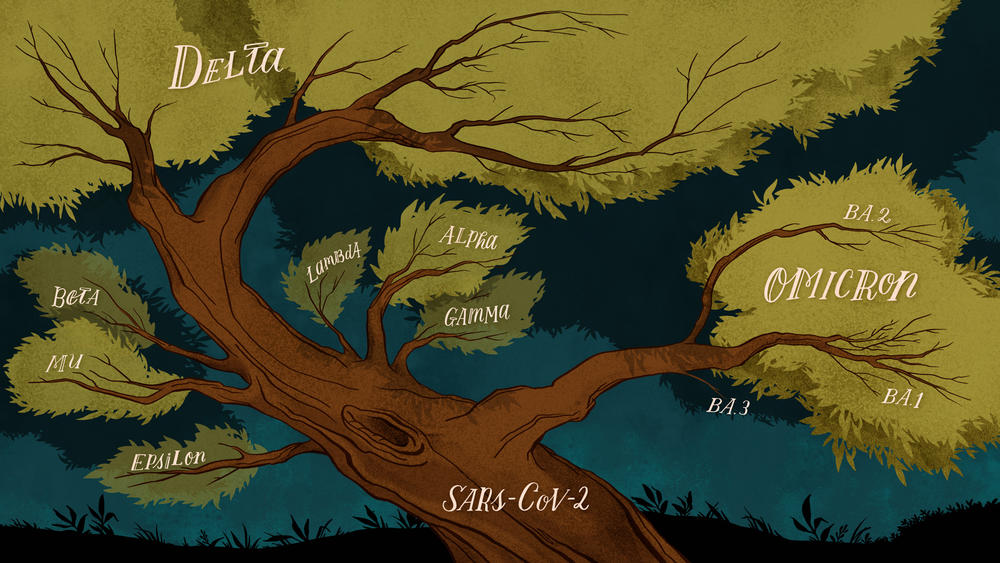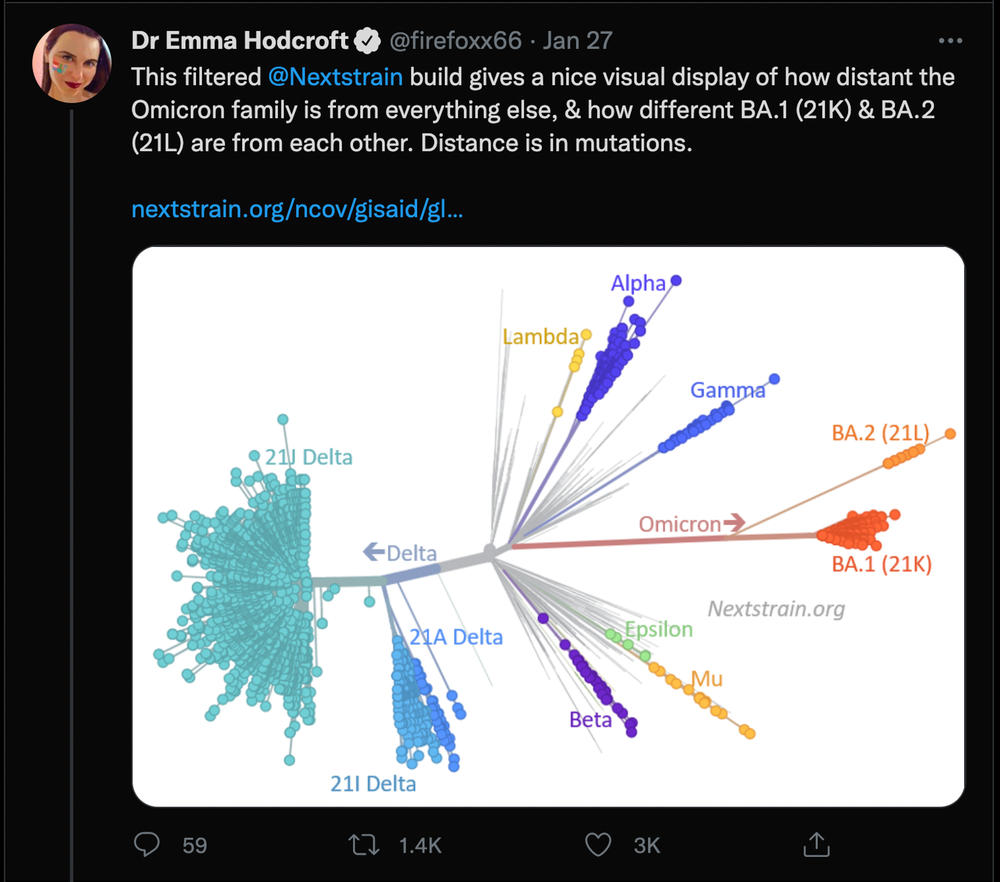Section Branding
Header Content
Take a look at SARS-CoV-2's family tree. It's full of surprises
Primary Content
In many ways, viruses are like families — giant, complicated, extended families with cousins, aunts, uncles, grannies and grandpas galore.
Just as with human families, scientists can generate family trees for viruses, showing how each member (or variant) is related to the others. Children are connected to parents by branches, and cousins are connected through their grandparents.
For viruses, these family trees give biologists insights into how a virus has evolved over time and what changes to expect in the future.
During the pandemic, the family tree of SARS-CoV-2, the coronavirus that causes the disease COVID-19, has produced more surprises than anyone expected.
It turns out the SARS-CoV-2 family had two black sheep that it kept hidden from the world. When those relatives appeared, seemingly out of the blue this autumn, they not only shocked the world, but they also made evolutionary biologists question their understanding of the pandemic's future.
Yes, I'm talking about omicron BA.1 and its sibling BA.2.
Early doubts that the coronavirus would change
When SARS-CoV-2 first emerged, many virologists thought they knew how it would evolve: slowly and minimally.
They were skeptical that the coronavirus would change much at all, says virologist Ravi Gupta at the University of Cambridge.
"Everyone had been telling us that SARS coronavirus doesn't mutate very much and therefore we're not going to see mutations that evade our immunity," he says. "But I just wanted to kind of see whether that was really true."
Virologist Jeremy Luban at the University of Massachusetts Chan Medical School heard the same skepticism. "In March 2020, I tried to write a grant application to study variants. And I have to say, I got a lot of flak from colleagues who were saying, 'You know, this virus isn't going to mutate anyway.' "
At first, Luban's and Gupta's colleagues looked to be correct. During the first year of the coronavirus pandemic, the virus didn't change that much. SARS-CoV-2 picked up only about one or two mutations each month.
In fact, the SARS-CoV-2 family tree seemed a bit boring, like a young sapling tree with one main trunk rising up into the sky and a few tiny little branches.
Then in December 2020, the course of the pandemic shifted. And Luban and Gupta proved prophetic.
Scientists in South Africa and the U.K. detected the first two variants of concern: alpha and beta. All of a sudden, the virus began to change rapidly. Instead of having only a few mutations as earlier variants did, these variants had around 20 mutations each.
At the same time, the SARS-CoV-2 family tree grew more complex and interesting. Branches for a bunch of variants sprouted off the main trunk. Gamma, lambda and mu appeared (although none of these variants ended up spreading across the globe). And up at the top of the tree, dozens of delta branches formed a broad overarching canopy.
Aha! — scientists thought. We now understand how SARS-CoV-2 is evolving and how this family tree is going to grow. The future appeared clear again: The next variants of concern would emerge at the top of the tree, from the delta canopy.
"At this point, focus of genomic surveillance should be to identify sub-lineages of Delta bearing mutations that contribute to further transmissibility ... expect such sub-lineages to emerge in the coming months," tweeted Trevor Bedford, who's a computational biologist at the Fred Hutchinson Cancer Research Center.
So in November 2021, scientists again were confident about their vision of the SARS-CoV-2 family tree and the future of the pandemic. But again, they were wrong. The tree was actually hiding a massive branch.
Holy cow! Where did that huge branch come from?
The day before Thanksgiving, scientists in Botswana and South Africa discovered a whole new variant of concern that was spreading extremely quickly. The World Health Organization named it omicron. Right away, scientists sequenced its genome so they could place it on the family tree. They wanted to know: Who are omicron's grandparents? Who are its cousins?
"Normally when we get a new variant, we can see how the mutations pile up on each other over time, and we can estimate really well where it sits on the tree," says Emma Hodcroft, an epidemiologist at the University of Bern who has been tracking variants all around the world throughout the pandemic via the Nextstrain project.
For example, when the delta variant emerged in India back in December 2020, Hodcroft and her team could see quite clearly delta's ancestors — its parents and grandparents on the tree. So they could place it easily on the tree. "Of course we never know, like 100%. But in general, we have a good picture, for example, of how delta became delta," she says.
But omicron was almost like an orphan. It didn't have any close relatives on the tree. There are no parents, no grandparents, not even great-great-great-grandparents. Its genes just looked so different from the other genome sequences.
"This is the puzzle of omicron," Hodcroft says. "What was omicron before it was omicron? And that's what's causing a lot of the debate about omicron's origin. Where did it come from, and how did it happen? Because we just have no information essentially to help us build that picture. There's just no samples going back in time."
The "Omicron cluster is highly ... distinct from any known VOC [variant of concern] or variants of interest (VOI) and from any other lineages known to be circulating in southern Africa," bioinformatician Tulio de Oliveira and his colleagues, who discovered the variant, wrote in the journal Nature in January.
It's almost as if this massive branch on the SARS-CoV-2 family tree just appeared one day out of thin air, without any warning or signs that it was growing. And the initial highly transmissible omicron variant and its sibling BA.2 were at the end of the branch, ready to spread explosively around the world. Omicron BA.1 went on to sweep the world; BA.2 is now reported to be taking over in South Africa. (A third sibling also appeared, but so far it doesn't seem able to keep up with its globe-trotting siblings.)
Another possibility is that this omicron branch did grow slowly over time, but for some unknown reason, scientists couldn't see it. It was in effect invisible. Perhaps because the virus was evolving inside another animal, like a rodent, and then jumped back into people. Perhaps because the virus was evolving very rapidly inside a person who had a chronic infection. Or perhaps because the virus was spreading in parts of Africa that scientists weren't watching closely enough.
No one knows which hypothesis is correct, Hodcroft says. And this gap in our knowledge brings much uncertainty about the future of the pandemic. It means scientists are likely unaware of a pool of SARS-CoV-2 variants that are replicating, mutating and evolving over time, completely under the radar.
This prospect is "chilling," writes virologist William Gallaher on the site Virological.org. "The discomfort in discovering an entirely new and widely divergent VOC [variant of concern] ... is very real," writes Gallaher, who's at LSU Health New Orleans. "Beyond the medical impact of the Omicron variants, there is every reason to believe that this will happen yet again, as it did for Delta and now with Omicron."
Right now, there could be several other long — and invisible — branches growing on the SARS-CoV-2 tree, Hodcroft says. And in the coming months, one of those branches could sprout off another family of rapidly spreading variants, similar to omicron.
"This pandemic has always thrown the unexpected at us, right?" she says. "Every time we think we have SARS-CoV-2 figured out, we get something new to figure out."
What the future holds
On the surface, this uncertainty about the coronavirus seems a bit scary. It raises the possibility that a new variant could crop up that's more lethal than any previous variant.
That scenario is possible, says physician Roby Bhattacharyya, who's an infectious disease specialist at Massachusetts General Hospital and Harvard Medical School. "Variants that transmit better are going to be selected for, and it's kind of the luck of the draw whether that variant is also more severe or less severe."
Remarkably, however, our immune systems seem ready to handle whatever variant emerges. No matter what variant the coronavirus has thrown at us, including omicron, prior exposure to the virus (through either vaccination or a prior infection) has still offered good protection against hospitalization and severe disease.
Copyright 2022 NPR. To see more, visit https://www.npr.org.
Bottom Content


